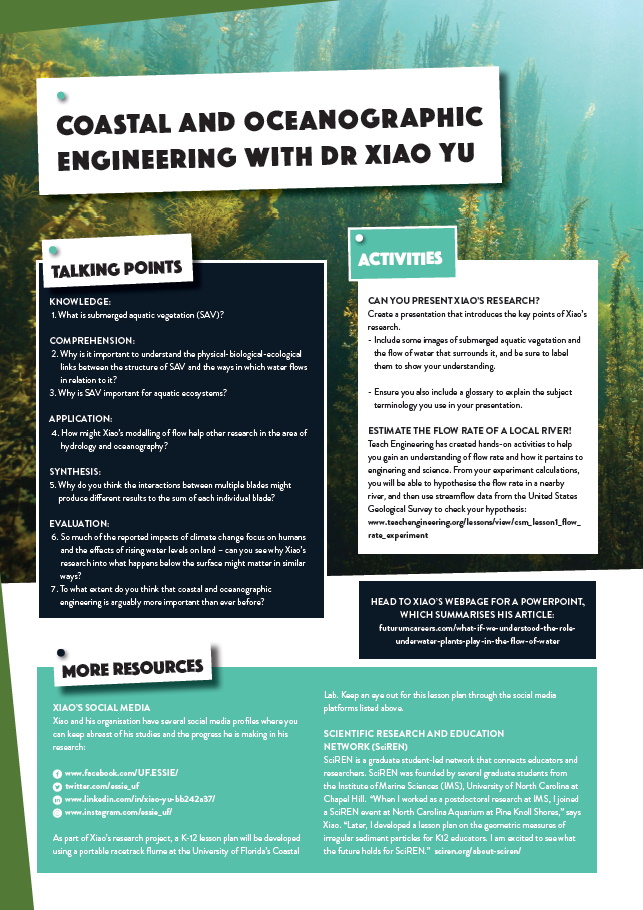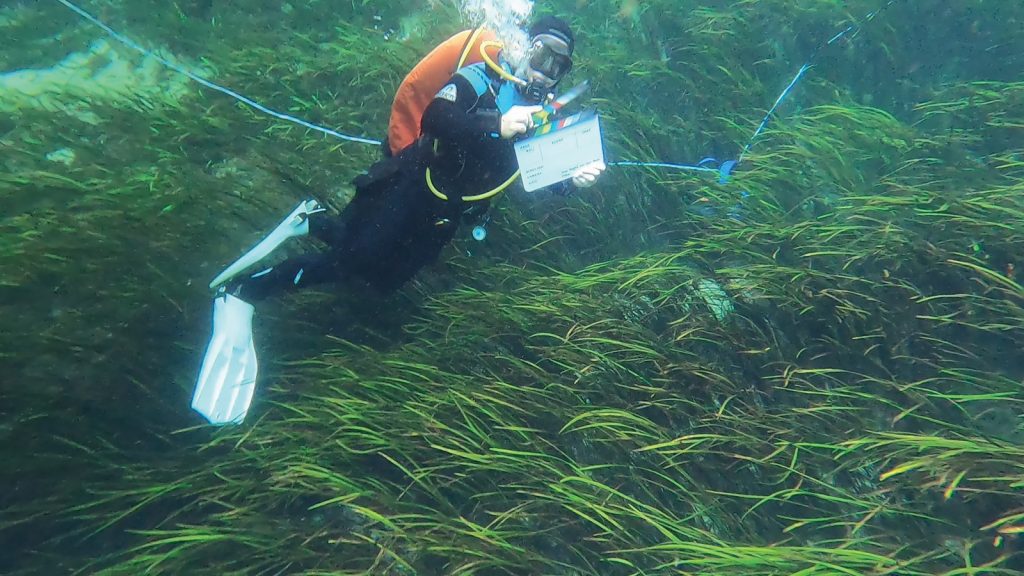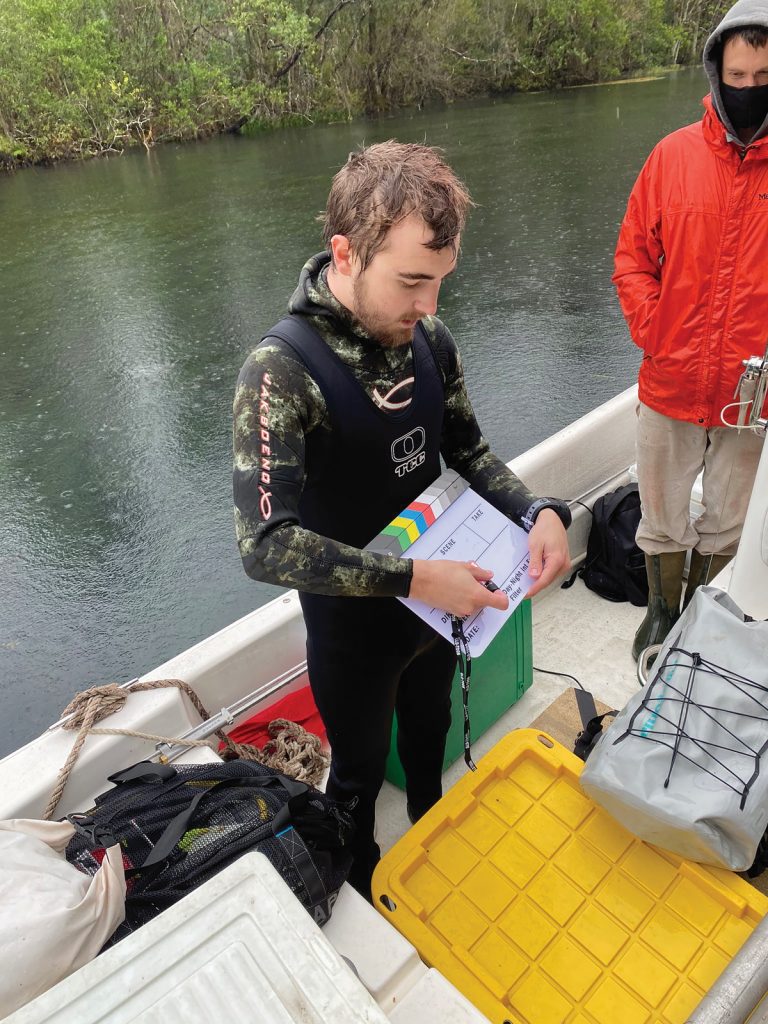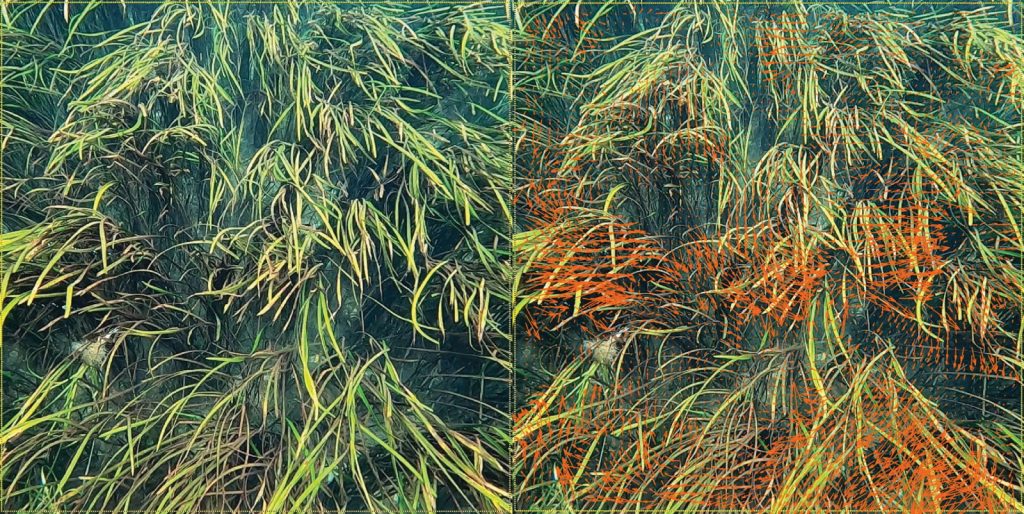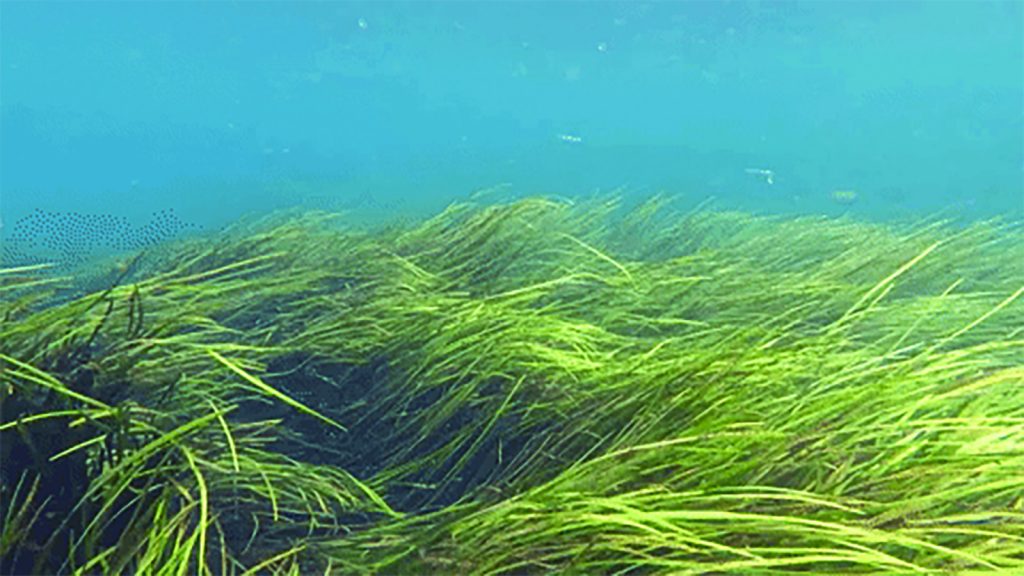What if we understood the role underwater plants play in the flow of water?
Dr Xiao Yu, based at the University of Florida in the US, is the principal investigator of a project that seeks to model the flow of water over submerged aquatic vegetation. The findings will help scientists study a variety of key ecosystem processes in rivers and estuaries
TALK LIKE A COASTAL AND OCEANOGRAPHIC ENGINEER
SUBMERGED AQUATIC VEGETATION – a rooted aquatic plant that grows completely under water
VEGETATION BLADE – the expanded part of a leaf or petal
BLADE-TO-BLADE INTERACTIONS – when multiple vegetation blades come into contact and interact with each other
DEFLECTED HEIGHT – the height of the vegetation blade when submerged under water. The deflected height is different from the length of the vegetation blade because the vegetation blade bends under the flow of water
HYDRODYNAMICS – a branch of physics that deals with the motion of fluids and the forces acting on solid bodies immersed in fluids (and hence the resistance forces acting on the fluid by solid bodies)
FLOW ATTENUATION – the action of slowing down the flow of water
TURBULENCE – fluid motion characterised by chaotic changes in pressure and flow velocity. Turbulence can be seen in everyday phenomena such as surf and fast flowing rivers
FLOW VELOCITY – the distance travelled by a fluid per time i.e., metre/second or feet/minute
MODELLING – the generation of a physical, conceptual or mathematical representation of a real phenomenon that is difficult to observe directly
NATURAL RESOURCES MANAGEMENT – using natural resources (land, water, soil, etc.) in a way and at a rate that maintains and enhances the resilience of ecosystems and the benefits they provide
TRANSPORT – a term used to describe the way in which rivers pick up and carry materials as they flow downstream
MONAMI – a coherent waving motion in flexible blades
CAUCHY NUMBER – the ratio of hydrodynamic drag force to the elastic restoration force. Visit this website for a revision of forces and elasticity: www.bbc.co.uk/bitesize/guides/
Submerged aquatic vegetation (SAV) is a term that refers to aquatic plants that grow completely under water. These plants reside in both freshwater and saltwater, but in estuaries – where both fresh and saltwater are often mixed together – they can be particularly important for aquatic organisms, which rely on SAV for food and shelter.
Indeed, SAV is a critical part of the ecosystems that exist in bodies of water and plays an important role in rivers and estuaries. If we picture the gentle movement of blades of grass and other vegetation below the surface of rivers and estuaries, we can see that the flow of water runs over and through this vegetation, which affects the flow.
Most of us would take this for granted and think no more of it – but for Dr Xiao Yu, who is a coastal and oceanographic engineer based within the Department of Civil and Coastal Engineering at the University of Florida, the flow of water that runs over and through submerged aquatic vegetation forms the basis of his latest project. His study aims to develop a framework for modelling flow over flexible SAV and quantify the influence of vegetation structural properties and blade-to-blade interactions on hydrodynamics, in particular flow attenuation and turbulent mixing processes.
By understanding the physical-biological-ecological links between the structure of SAV and the ways in which water flows in relation to it, Xiao hopes to uncover findings that will be of critical importance to natural resources management.
WHAT ARE BLADE-TO-BLADE INTERACTIONS?
A vegetation blade is the expanded part of a leaf (or similar) and a single, flexible blade reconfigures its posture with flow velocity. Naturally, as the flow velocity increases, the blade bends and the drag force is reduced. Thus, the extent of the bend greatly affects hydrodynamics (i.e. the flow of water). So good, so far. However, when we consider areas where there is dense vegetation, there is the possibility for a vast number of interactions. Think about the influence the flow of water has on multiple blades of vegetation – the bending and shaping of these blades will likely lead to many blades coming into contact and interacting with many others.
This is known as blade-to-blade interaction and although it is extremely complicated to study, it is vitally important, not least because the collective behaviour of vegetation blades could be significantly different from the total sum of each individual blade. It is here where Xiao’s modelling comes into play, as he attempts to use computational techniques to describe the interactions and the affect they have on the flow of water.
WHY IS IT IMPORTANT TO MODEL FLOW?
“When vegetation blades come into contact with each other, blade-to-blade interactions may alter the deflected height, so attributing the observed deflection height solely to the bending stiffness of a single blade is often insufficient,” says Xiao. This is what makes his project novel – he is investigating the influence of interactions among multiple blades, including both their hydrodynamic interaction and direct contacts. It is Xiao’s belief that these investigations will prove critical to describe the hydrodynamics at play, which are primarily driven by the whole canopy of vegetation.
IS CONTINUOUS SAV CANOPY MOTION A CONCERN FOR XIAO?
Yes! “Canopy-scale vortices can induce a waving motion in flexible blades, namely ‘monami’ when the vortex is strong enough to depress individual blades and the instantaneous drag force exerted by the vortices is greater than SAV buoyancy and rigidity,” explains Xiao. “The flexibility of the canopy and presence of ‘monami’ affect momentum transfer and mass exchange between the canopy layer and the overlying flow at large scales. This has ramifications for mass transport, sediment transport, residence times, biogeochemical processes and ecological interactions.”
HOW WILL XIAO’S STUDIES HELP ENGINEERS AND NATURAL RESOURCE MANAGERS?
SAV provides important ecological services in the rivers and estuaries of Florida (where Xiao’s studies are focused) and other parts of the world. Indeed, aquatic plants are an important habitat for a wide range of invertebrates, fish and other animals. They are also an important food source for various species, including those of conservation concern, such as the West Indian manatee. It is, therefore, concerning to learn that algae have been increasing in many Florida springs, which represents a threat to these ecosystems and could have devastating effects on the life situated within them.
Reference
https://doi.org/10.33424/FUTURUM234
SUBMERGED AQUATIC VEGETATION – a rooted aquatic plant that grows completely under water
VEGETATION BLADE – the expanded part of a leaf or petal
BLADE-TO-BLADE INTERACTIONS – when multiple vegetation blades come into contact and interact with each other
DEFLECTED HEIGHT – the height of the vegetation blade when submerged under water. The deflected height is different from the length of the vegetation blade because the vegetation blade bends under the flow of water
HYDRODYNAMICS – a branch of physics that deals with the motion of fluids and the forces acting on solid bodies immersed in fluids (and hence the resistance forces acting on the fluid by solid bodies)
FLOW ATTENUATION – the action of slowing down the flow of water
TURBULENCE – fluid motion characterised by chaotic changes in pressure and flow velocity. Turbulence can be seen in everyday phenomena such as surf and fast flowing rivers
FLOW VELOCITY – the distance travelled by a fluid per time i.e., metre/second or feet/minute
MODELLING – the generation of a physical, conceptual or mathematical representation of a real phenomenon that is difficult to observe directly
NATURAL RESOURCES MANAGEMENT – using natural resources (land, water, soil, etc.) in a way and at a rate that maintains and enhances the resilience of ecosystems and the benefits they provide
TRANSPORT – a term used to describe the way in which rivers pick up and carry materials as they flow downstream
MONAMI – a coherent waving motion in flexible blades
CAUCHY NUMBER – the ratio of hydrodynamic drag force to the elastic restoration force. Visit this website for a revision of forces and elasticity: www.bbc.co.uk/bitesize/guides/
Submerged aquatic vegetation (SAV) is a term that refers to aquatic plants that grow completely under water. These plants reside in both freshwater and saltwater, but in estuaries – where both fresh and saltwater are often mixed together – they can be particularly important for aquatic organisms, which rely on SAV for food and shelter.
Indeed, SAV is a critical part of the ecosystems that exist in bodies of water and plays an important role in rivers and estuaries. If we picture the gentle movement of blades of grass and other vegetation below the surface of rivers and estuaries, we can see that the flow of water runs over and through this vegetation, which affects the flow.
Most of us would take this for granted and think no more of it – but for Dr Xiao Yu, who is a coastal and oceanographic engineer based within the Department of Civil and Coastal Engineering at the University of Florida, the flow of water that runs over and through submerged aquatic vegetation forms the basis of his latest project. His study aims to develop a framework for modelling flow over flexible SAV and quantify the influence of vegetation structural properties and blade-to-blade interactions on hydrodynamics, in particular flow attenuation and turbulent mixing processes.
By understanding the physical-biological-ecological links between the structure of SAV and the ways in which water flows in relation to it, Xiao hopes to uncover findings that will be of critical importance to natural resources management.
WHAT ARE BLADE-TO-BLADE INTERACTIONS?
A vegetation blade is the expanded part of a leaf (or similar) and a single, flexible blade reconfigures its posture with flow velocity. Naturally, as the flow velocity increases, the blade bends and the drag force is reduced. Thus, the extent of the bend greatly affects hydrodynamics (i.e. the flow of water). So good, so far. However, when we consider areas where there is dense vegetation, there is the possibility for a vast number of interactions. Think about the influence the flow of water has on multiple blades of vegetation – the bending and shaping of these blades will likely lead to many blades coming into contact and interacting with many others.
This is known as blade-to-blade interaction and although it is extremely complicated to study, it is vitally important, not least because the collective behaviour of vegetation blades could be significantly different from the total sum of each individual blade. It is here where Xiao’s modelling comes into play, as he attempts to use computational techniques to describe the interactions and the affect they have on the flow of water.
WHY IS IT IMPORTANT TO MODEL FLOW?
“When vegetation blades come into contact with each other, blade-to-blade interactions may alter the deflected height, so attributing the observed deflection height solely to the bending stiffness of a single blade is often insufficient,” says Xiao. This is what makes his project novel – he is investigating the influence of interactions among multiple blades, including both their hydrodynamic interaction and direct contacts. It is Xiao’s belief that these investigations will prove critical to describe the hydrodynamics at play, which are primarily driven by the whole canopy of vegetation.
IS CONTINUOUS SAV CANOPY MOTION A CONCERN FOR XIAO?
Yes! “Canopy-scale vortices can induce a waving motion in flexible blades, namely ‘monami’ when the vortex is strong enough to depress individual blades and the instantaneous drag force exerted by the vortices is greater than SAV buoyancy and rigidity,” explains Xiao. “The flexibility of the canopy and presence of ‘monami’ affect momentum transfer and mass exchange between the canopy layer and the overlying flow at large scales. This has ramifications for mass transport, sediment transport, residence times, biogeochemical processes and ecological interactions.”
HOW WILL XIAO’S STUDIES HELP ENGINEERS AND NATURAL RESOURCE MANAGERS?
SAV provides important ecological services in the rivers and estuaries of Florida (where Xiao’s studies are focused) and other parts of the world. Indeed, aquatic plants are an important habitat for a wide range of invertebrates, fish and other animals. They are also an important food source for various species, including those of conservation concern, such as the West Indian manatee. It is, therefore, concerning to learn that algae have been increasing in many Florida springs, which represents a threat to these ecosystems and could have devastating effects on the life situated within them.
“Recent studies suggest that reductions in flow velocity can prevent ‘monami’ generation and blade-to-blade interactions that inhibit undesired algae growth,” says Xiao. “Understanding the physical-biological-ecological coupling in rivers and estuaries with flexible SAV can provide support for natural resources management and guidance for the protection and restoration of aquatic ecosystems, such as the minimum flow requirement.”
WHAT HAVE BEEN THE KEY FINDINGS OF XIAO’S PROJECT?
One of the main findings of the project so far concerns the inclusion of blade-to-blade interactions. By including them, the deflection height of SAV is reduced, meaning larger drag. “The dynamics primarily depends on the Cauchy number, vegetation density and the ratio of the characteristic length scales of ‘monami’ to the spacing of adjacent blades,” says Xiao.
Ultimately, by developing a model that can investigate the deformation of vegetation blades and interactions between multiple blades, Xiao and the team hope to better understand the effects of SAV on key ecosystem processes, such as sediment transport and algae growth. Science is often for its own end – and Xiao’s work certainly attests to this –, but the life that relies on ecosystems and SAV could benefit from the findings.
 DR XIAO YU
DR XIAO YU
Assistant Professor, Department of Civil and Coastal Engineering, University of Florida, USA
FIELD OF RESEARCH: Coastal and Oceanographic Engineering
RESEARCH PROJECT: Understanding the influence of underwater plants (submerged aquatic vegetation) on hydrodynamics and their collective behaviour under different flow conditions
FUNDER: National Science Foundation (NSF)
 DR XIAO YU
DR XIAO YU
Assistant Professor, Department of Civil and Coastal Engineering, University of Florida, USA
FIELD OF RESEARCH: Coastal and Oceanographic Engineering
RESEARCH PROJECT: Understanding the influence of underwater plants (submerged aquatic vegetation) on hydrodynamics and their collective behaviour under different flow conditions
FUNDER: National Science Foundation (NSF)
ABOUT COASTAL AND OCEANOGRAPHIC ENGINEERING
Given the current and future impacts of climate change, now is arguably the most important time for coastal and oceanographic engineering. As the polar icecaps melt, water levels will rise around the world and this will have significant impacts on coastal communities and areas.
Coastal and oceanographic engineering is one notable field that will help to drive research and innovation in areas that will help humanity overcome some of the challenges associated with climate change – not just for human populations, but for the animals and other organisms that rely on ecosystems in and around bodies of water. As Xiao’s research shows, it is possible to combine several seemingly independent research interests in order to solve various challenges.
WOULD XIAO RECOMMEND A CAREER IN COASTAL AND OCEANOGRAPHIC ENGINEERING?
In a word, yes. Xiao is unequivocal in his passion for the field. “I would definitely recommend a career in the field,” explains Xiao. “There are a lot of exciting opportunities in coastal and oceanographic engineering for next-generation scientists and engineers: the sustainable delivery of economic, social and environmental benefits associated with coastal infrastructure; underwater exploration using remotely operated underwater vehicles (ROVs); the floating city by Oceanix that can withstand a Category 5 hurricane.”
EXPLORE A CAREER IN OCEANOGRAPHIC ENGINEERING
• Marine Careers is an essential resource for those looking to develop a career in ocean engineering and related fields. This site really should be able to answer any questions you might have: www.marinecareers.net/ocean-engineering
• The University of Florida’s College of Engineering provides a wealth of information relating to coastal and oceanographic engineering, including some of the exciting research that is taking place and useful resources: www.eng.ufl.edu
• “We also offer scholarships to high school students and teachers who want to work with our faculty, and graduate students and undergraduate students who want to explore university-level research,” explains Xiao. “The students are given opportunities to present their research at STEM research competitions or during non-competitive poster sessions.”
• In the US, ocean engineers make an average of $73,000 per annum, but this is largely dependent on the particular job role being performed. You could be a marine biologist, marine engineer or coastal engineer, to name a few, and all have different average salaries.
Xiao began by studying hydraulics before moving on to ocean engineering. As such, there is no pre-defined pathway and it really rather depends on exactly what you want to do. However, as with any form of engineering, a solid basis in mathematics and science while at school and college – particularly physics – will be important. Given some of the work that Xiao is engaged in, biology and computing could be useful.
XIAO’S TOP TIPS
01 Be an active learner. Curiosity has always been the driving force behind research; asking ‘why?’ and ‘how?’ will keep science moving forward.
02 Actively seek out research opportunities from an early stage. It will stand you in good stead and give you an idea of what to expect if you pursue a career in academia.
03 Staying motivated is so important for a successful career – if you can find a research topic you are passionate about, half the battle is already won.
MEET XIAO
The Three Gorges Dam project inspired me to study hydraulic engineering. It was one of the largest engineering projects in China and the largest dam structure in the world. When I studied within the Department of Hydraulic Engineering at Tsinghua University, I learned the environmental impacts of water infrastructure and decided to focus on environmental fluid mechanics and sediment transport for my PhD.
I always wanted to be a scientist when I was younger. My mother was a middle school chemistry teacher and she inspired me to pursue a STEM career. We constantly face challenging research problems and by working with researchers from other disciplines, I am exposed to new ideas and perspectives, which enables me to see things from different angles. I also enjoy learning about new technologies (such as machine learning) and applying them in my own research.
My long-term goal as an educator is to engage students in interdisciplinary STEM careers and prepare them by imbuing them with the skills they need to solve challenging, practical engineering problems. One of the greatest challenges the US is facing now in graduate-level engineering programmes is the decreasing number of undergraduate students who pursue their studies for career development in the highly challenging technology area – particularly underrepresented and women students. It is, therefore, very important to develop effective ways to engage students to pursue STEM careers by offering them first-hand research experience opportunities so they can realise the benefits.
MEET ROB

Rob Taylor is an undergraduate student in environmental engineering at the University of Florida, working with Xiao on the NSF-funded project: A framework for modelling flow over flexible submerged aquatic vegetation.
My role in the project is primarily validating model results with field observations. The work is varied, ranging from building mounts for the cameras and velocity instruments, to scuba diving and running the experiment in the field, and analysing the images to extract the data we are looking for.
I was never the child who knew exactly what I wanted to do with my life. In fact, I didn’t even want to attend college after high school. The pragmatic and hardworking side of me thought I would be a charter fisherman, and the creative in me wanted to pursue music or filmmaking. However, after encouragement from many family members and friends, and without feeling forced into it, I decided to attend community college. I eventually landed on environmental engineering for my bachelor’s degree because of my long history with Florida’s ecosystems.
Solving math and physics problems really stimulates my mind in a unique and pleasurable way. As I have moved along in my studies, and systems have gotten more complex, I’ve started to realise that so many of the engineering problems that we solve just boil down to a collection of physics problems like those learned in the early years of my studies. I also love how so many of the topics we study can be directly applied in industry and help the environment.
Immediately after graduation, I plan on working in environmental consulting for some time. The position I’m in now keeps me in the field for 20-25 hours a month doing mostly flow monitoring on Florida rivers for public projects. I will likely stay with the company after graduation and fill the rest of my hours with engineering work such as hydrologic modelling, coastal design, geographic information systems (GIS) work and data analysis.
In the end, I want to be able to make a direct impact in areas like environmental protection and ecological restoration, educate the public about climate systems and how humans impact them, and help solve the technical, social, economic and political issues that will undoubtedly come along with climate change.
Do you have a question for Xiao or Rob?
Write it in the comments box below and Xiao or Rob will get back to you. (Remember, researchers are very busy people, so you may have to wait a few days.)


